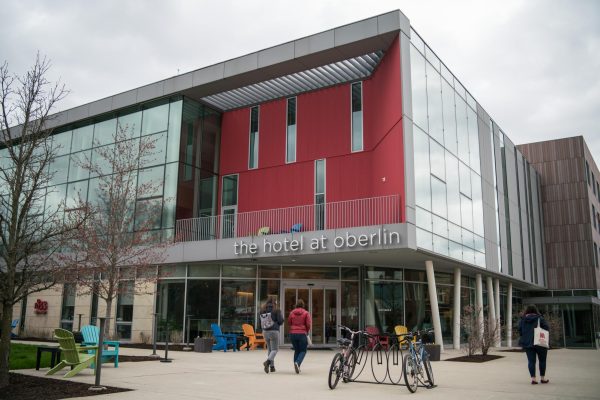College Projects Enrollment Rebound
After a significant enrollment shortfall that led to a $5-million deficit, the Office of Admissions and Financial Aid projects that Oberlin College and Conservatory will meet its target admission rate for the class of 2022, reducing the deficit by approximately $2 million. The office examined and has been responding to trends in high school graduate demographics, prospective student feedback, and issues concerning lower retention to help recover enrollment numbers.
Interim Vice President and Dean of Admissions and Financial Aid Manuel Carballo said 169 Early Decision-I applicants have been accepted, while Early Decision-II is expected to bring in roughly 65 new commits, and 23 students who deferred their admission last year will join the class of 2022. Carballo said that overall, the College and Conservatory are on track to meet their enrollment goals of 620 and 130 students, respectively, for next year.
The projections for next year come on the heels of this year’s under-enrollment, which Interim Vice President of Finance and Administration Alan Norton said caused the major deficit.
“Last May, the projected enrollment was reduced by 100 students, from 2,900 to 2,800 and that eliminated $4.9 million of net revenue,” he said. “It turns out that the actual enrollment came in a little higher at 2,827, and as the year has gone along there have been both some unplanned expenses but also some unplanned savings.”
In light of next year’s increased projected enrollment rates, however, Norton anticipates that the $2-million reduction in the deficit will emerge with additional plans to cut spending.
Carballo said that shifts in demographic trends include population decline in the Midwest and New England, population growth in the South and Southwest, growth in African-American and Hispanic populations, and decreased numbers of students graduating from private high schools. These are trends that all American liberal arts institutions, not just Oberlin, are encountering.
“We are still going to a lot of the same places, but it does mean spending more time in the South or Southwest, more time in the West,” Carballo said. “It’s looking at, in the next couple years, spending more time on international [outreach], and so instead of being at eight percent, maybe being closer to 10 to 12 percent. The Arts and Sciences admissions has also increased travel to high schools, visiting 45 percent more high schools in 2017 than in 2016.”
Admissions is also practicing a more targeted, personal approach to communication by increasing outreach to areas that traditionally attract students to Oberlin but have shown a decrease in high school graduation rates.
To combat this year’s admission decline, the Office of Admissions launched the fall Phone-A-Thon program, which has Oberlin students call prospective students who have expressed an affinity for Oberlin. Students who could not be reached by phone were sent postcards, and all prospective students have been receiving emails in their inboxes every week with answers to the question: “Why Oberlin?”
With just over a month until regular decision acceptances are released, glimpses of what the class of 2022 will look like are starting to crystallize. Soon, the campus will add the accomodation of incoming students to its existing priority of addressing concerns about student life.
At the forefront of student life improvements are students themselves. In November, Student Senate conducted a campus-wide survey to assess the campus climate and student needs, as well as investigate reasons for Oberlin’s recent dip in retention rates.
“A big thing that we saw when we were looking at Senate priorities was that people were really interested in more student spaces … which was really lovely to see,” Student Senator and College junior Cecilia Wallace said after preliminary analysis of the survey. “I think students just want to feel more connected to other students.”
Senate is subsequently working to build more social and accessible spaces to cultivate a greater atmosphere and sense of community on campus.
All Roads Lead to Oberlin — the April campus visit program for accepted students — will also receive a makeover to further boost enrollment numbers. In recent years, All Roads has brought over 550 admitted students in their families to campus, allowing them to engage in lectures, tours, and student panels. All Roads’ goal is to present the most well-rounded picture of Oberlin possible.
Although All Roads has consistently received positive reviews from those who attend, feedback from previous years has led the Admissions team to make some adjustments to the program.
“Each All Roads program will now be a one-and-a-half- to two-day event instead of just a one day event like it was in the past,” said Senior Assistant Director of Admissions Jessica Cummings, OC ’10. “Some of the new programming we are planning will include a parent reception, sessions for prospies that are led by PALs, a formal speech by President [Carmen Twillie] Ambar, and an academic fair that will involve every academic department.”
Cummings added that past All Roads feedback indicates that prospective students want more interaction with faculty and other prospective students. The Office of Admissions will adapt the program to meet those requests.
Norton said that amid the changes implemented to compensate for the financial deficit, one thing that will not change is Oberlin’s commitment to meet full financial need for admitted students. Some current students have expressed concern that Oberlin will admit a class of students who come from a higher average socioeconomic status to offset the College’s financial struggles.
“Financial aid will not be reduced because we have a deficit,” Norton said. “The College is committed to meeting financial need, so we will have to find other things to change to reduce expenses or increase revenue.”
Admissions staff assure students that despite Oberlin’s economic hardships, financial aid and a diverse student body remain their highest priority.
“We are need-aware, so we do look to see whether students have applied for aid or not, but there is a real commitment at Oberlin — because of our history in terms of diversity — to make sure that we are meeting full need,” Carballo said. “I think that, while we are always looking to do better, a lot of schools are looking at us and saying, ‘I wish we could do what Oberlin is doing.’”




